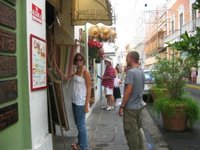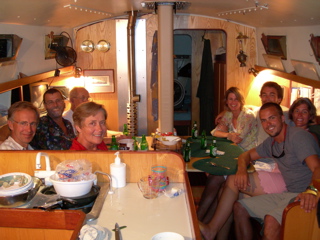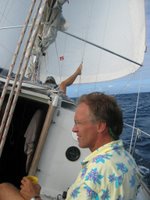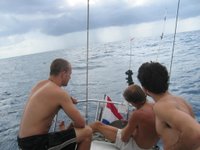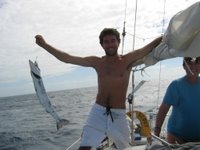I. Guirmo the Shoeshine Boy
¨Where you from¨?¨
¨Los Estados Unidos, I replied with a strange and awkward spanglish accent.
Ï shine your shoes,¨ and the boy began to get on his knees and grab my feet. I was wearing sandals. I don´t know what he was planning on shining. Maybe the rubber soles. It didn´t matter.
The shoeshine boys are as much a part of Santo Domingo as the cobbled street on which they chased after tourists. Their boxes are small rickety wooden pails that house an assortment of rags, polish and dirt. They run up and down Calle Conde looking for sympathizing tourists and the occasional Dominican who has the time to placate these boys´ business.
After convincing the boy that I did not need my sandals polished I asked him his name.
¨Como se llama?¨
¨Gueirmo¨, he said.
¨Me llamo David.¨
Guerimo could be no more than 10. His eyes were bright blue that seemed to have its origins in the Carribbean waters. His attire was simple, as is I guess most 10 years olds throughout the world, but characteristically ragged. Blue shorts and yellow t-shirt with a picture of the skyline of New York from the Hudson River silk-screened on the front. He was wearing a Licey baseball hat he must have found outside the stadium one night after a loss. Some agitated fan must have thrown it on the ground in his drunken anger and left it for Gueirmo to find.
¨Te gusta Licey,¨ I asked.
¨Si, si you like I shine your shoes, you give me 50 pesos.¨
We had been walking and talking as I saw no sense to indulge Guirmo´s sandal-shining proposition any futher when we came upon some sort of ceremony outside of the iglesia. Gueirmo commanded be to stop.
We stood in silence as we watched the Dominican flag being taken down from the top of the iglesia and in strict military code, folded neatly and returned inside the church. Cars had stopped their honking tourists had ceased thier chatter, and for a brief moment in a city of babbling geese, there was quiet. The hustlers had gone inside their shops, the chicas bandidas sat solemnly, the cab drivers stopped hailing tourists and while I knew it would last only a moment there was a sense of respect about the whole process.
And there I stood next to Gueirmo, holding his shoeshine box with his brightly colored clothes, his crystal clear eyes that fell softly on any passerby, and I caught a glimpse of what this city is really about. Its people.
The tableaux lasted for only a moment and when the military guard had secured the flag and gone inside the iglesia the world resumed again. Cars moved on, the cabbies lobbied tourists, the tiendas hustled people inside and Geuirmo began to polish my sandals. I pulled up a chair and sat there and watched it all as Gueirmo took his dirty rags to my feet and cleaned the straps and soles of my sandals. This was Santo Domingo.
II. The Chess Game
On the Calle Conde there are many things. While the policia tries to keep them away, even the chicas bandidas manage to get a spot on Duarte. There is La Despensa, the supermarket, La Cafeteria, where the old-timers drink their cafe and talk about Licey or other matters of national importance. The tourists dominate Calle Conde and there are enough sidewalk vendors and tienda hustlers to accomate the most unwilling cruise ship passenger.
Amongst the bustle of the ped-mall there is the chess game. Run by four or five regulars and complemented by several more sporadic players the Calle Conde chess game is the most out of place event on a street where hookers hide from the rain in the internet cafe.
Ricardo is the champion. While he loses occasionally no one considers themselves better than Ricardo. This is not Ricardo´s choice, for he is certainly not the kind of man to raise is nose to anyone. It is simply what the others have decided.
The game is speed chess. You have a timer that is acts on a hinge and after each player makes a move he switches the clock to his opponent.
Click, Click, Click. Those are the sounds of the timer as Ricardo and his opponent move their pieces. Someone more romantic than I could argue that the cadence of the game is part of the art. I, however am not one to exaggerate the importance of such things but only bring it up to show how graceful the game is.
I am the lone gringo in the group and my presence, while acceptable is certainly conspicuous. I watch with eager eyes as Ricardo moves in position to check and ultimately mate his opponent.
The men (they are only men -- i think a woman´s presence would be even more conspicuous then mine) huddle around talking quietly as to not disturb the players. They have formed an exclusive circle that for them is a kind of refuge. Around them Calle Conde continues on its frenetic pace as the next round of cruisers must be corralled and convinced to by the t-shirt they don´t need or a necklace to give to their wife or mistress. But inside, Ricardo is king and the men around him have nominanted him so. He is their king and chess is their domain.
Ricardo´s opponent concedes before he is mated but there is no animosity. The game exists beyond winning and losing. The next challenger sits down and the loser assumes his position in the circle. I slip away quietly and wander down the street.
¨Taxi, taxi¨
¨Gift for your wife sir, come inside¨
¨Hand job for 200 pesos¨
I make my way back to my refuge and salvation and drift into a quiet and lovely sleep.
III. Calle Conde
The stream of tourists had not ceased since 9am. They were let off the boat and given wristbands and instructions on when to be back. Their attire was fairly standard: white shoes with white socks pulled up to the calf. Khaki shorts, a flowered tropical shirt for the men and a souviner t-shirt from the last cruise for the women. The guide book and their friends back home told them to wear a hat and lots of sunscreen. Those who heeded this advice wore a straw hat and SPF 130. Those who promised to come back with a tan and impress their girlfriends´ best friend wore nothing and had already begun to peel and look like a lobster.
I sat in Parque Colon watching the delightful mix of school children, tourists and taxi drivers as they floated past. It was almost noon and the sun seared the truth of the tropics into every one it hit. This was not a paradise. The Corona commercials were bullshit. They filmed those in some studio in Malibu. You could see the looks on the faces of the overweight couple who had come from Iowa for their vacation in the tropics. It was as if they said,
¨Lets get the hell out of here and freeze our asses off in Cedar Bluff.¨
The cruise ships had an arrangement with the local tour companies to feed them their passengers. Thus, the path from the cruise ship to the tours was made very easy. The tour took them through the Ciudad Colonial around the fort and back down Calle Conde to the cruise ship. This was a very defined path and, since I had been there since 9 I had seen many groups make the loop.
In Santo Domingo as the day wears on and the sun rages, the trash on the corner piles up. The dogs and Haitians come out from under the cars and begin to rummage through the garbage looking for the days meal. As the day turns to night, the trash increases in size and dimensions. By morning, when the next cruise ship has arrived and started to unload passengers, the trash has been picked up and taken outside the city away from the wallets of the tourists.
This was the way Santo Domingo worked. However on this day, the day I was sitting in the Parque Colon, the trash had not been picked up the night before. Tourists were herded along their usual path down the Calle Conde and across Calle de Catolica. By noon the dogs and Haitians had begun to emerge and begin their daily feast of rotting trash and garbage. I sat there as Joe and Mary from Lima, Ohio listened to their tour guide talk about the Spanish architechure while just yards away a Haitian and a dog fought over the rotten head of lettuce that lay on the corner under the garbage bags. This scene continued for the next several hours as tourist and scavenger alike got a glimpse of Santo Domingo. And I sat there and watched as the sun faded, and the children went home and the taxi drivers left. But those who remained were the men and women forgotten by the Lonely Planet, unmentioned by the tours and left to fight tooth and nail to survive. I left the Parque and walked home leaving behind me a city of contrasts marked by the tableaux of poverty and indifference.
This log has been kept by crew and captain over the past several months. Pictures and wonderful essays have kept many friends and strangers informed about the adventures of Sea Scout. I have been in the islands about a month now and with Geert and Sea Scout for 3 weeks. My time aboard has been exceptionally enjoyable and the people I have met along the way have been incredibly friendly and nice.
I wrote these stories because I wanted to do something different than what had previously occupied space on this log. I hope I have not attempted something outside of my skills as an observer, writer or crewmember. Additionally I want to stress that these stories, while non-fiction, represent just a fraction of Santo Domingo. Its beauty and its people are first-class and I would not have been so moved by what I have seen if it werent so.
That said, I hope these stories offer a unique insight into Santo Domingo and more importantly into the type of adventures Sea Scout was built for. We have a long way to go and unfortunately our next destination is more destitute and poverty-stricken. I hope to find another unique way to contribute to the log of the sea scout after we have visited Haiti.
-dg
